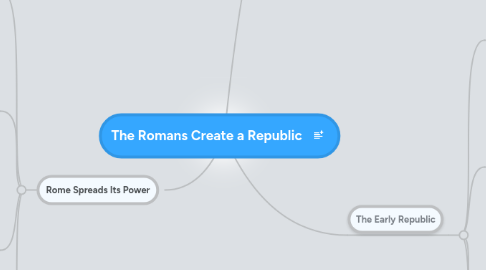
1. Rome Spreads Its Power
1.1. Rome Conquers Italy
1.1.1. Roman power grew Steadily as legions battled.
1.1.2. In 390 B.C. the Gauls (Celtic people from the Po River Valley) Sacked Rome.
1.1.2.1. Rome quickly recovered and rebuilt the city.
1.1.3. Rome reestablished control by defeating and reconquering one rival at a time.
1.1.3.1. By 265 B.C. the Romans were masters of all Italy save the Po Valley
1.1.3.2. Rome had different laws and treatments for different parts of their conquered territories.
1.2. Rome's Commercial Network
1.2.1. Easily had access to the Mediterranean Sea.
1.2.1.1. Roman Merchants used both land and sea
1.3. War with Carthage
1.3.1. 246 B.C. Rome and Carthage began the Punic Wars
1.3.1.1. First Punic War
1.3.1.1.1. Fought for the control of Sicily and the Western Mediterranean.
1.3.1.2. Second Punic War
1.3.1.2.1. Began in 218 B.C. masterminded by Hannibal. 50,000 infantry, 9,000 cavalry, and 60 war elephants were assembled with the intent of capturing Rome. Traveled from Spain across France and through the Alps.
1.3.1.2.2. After losing more then half his men, and most of his elephants Hannibal invaded Northern Italy.
1.3.1.3. Third Punic War
1.3.1.3.1. In 146 B.C.Rome was not threatened by Carthage anymore, but still set out to wipe it off the map.
1.4. Rome Controls the Mediterranean
1.4.1. Due to their Punic War victories, were granted domination over the western Mediterranean.
1.4.2. Rome went on to conquer the eastern half
1.4.2.1. Took control of Macedonia, Greece, and parts of Anatolia
1.4.3. By 70 B.C. Rome's Mediterranean empire stretched from Anatolia on the East, to Spain on the West.
2. The Beginnings of Rome
2.1. According to Legend, city was founded in 753 B.C. by Romulus and Remus. Developed because of its strategic location and fertile soil.
2.1.1. Rome not only held the roman people, but Etruscan, Latin's, and Greek's.
2.1.1.1. Rome also borrowed many Religious ideal's from both the Greek's and the Etruscan'.
2.1.2. Roman cities became prosperous and commercially active in approx. 750 - 600 B.C.
3. The Early Republic
3.1. Patricians and Plebeians
3.1.1. Patricians - Aristocratic landowners who held most of the power
3.1.2. Plebeians - common farmers, artisans, and merchants who made up most of the population
3.1.2.1. Had the right to vote - eventually got more power from pressuring patricians
3.1.3. Tribunes - representatives allowed by the Roman Senate to protect the Plebeians from unfair acts of Patrician power.
3.2. Twelve Tables
3.2.1. Plebeians forced the creation of a written law code
3.2.1.1. Without written law, patrician officials interpreted the law to suit themselves.
3.2.1.2. 451 B.C. 10 officials sat down and wrote laws on 12 tablets
3.2.1.2.1. Hung in the Forum, but established idea all free citizens, both Patricians and Plebeians, had right to protection of the law
3.3. Government Under the Republic
3.3.1. Government had taken best features of 3 governments and combined them. Monarchy, Aristocracy, and democracy.
3.3.1.1. Rome had 2 officials called Consuls, they commanded the army and directed the government
3.3.1.2. Senate - was the aristocratic branch of Rome's government
3.3.1.2.1. traditonally featured 300 members chosen forom the patricians, however plebeians finally gained access. Membership was for life. Exercised enormous influence over both foreign and domestic policy
3.3.1.3. Dictator - a leader who had absolute power to make laws and command the army. Power only lasted for 6 months, and were chosen by consuls and elected by senate
3.4. The Roman Army
3.4.1. All citizens who owned land were required to serve in the army.
3.4.1.1. Some public offices required 10 years of military service in order to hold
3.4.2. Roman Legion
3.4.2.1. Made up of some 5,000 heavily armed foot soldiers. Cavalry supported each legion.
3.4.2.1.1. The 5,000 soldiers were split up into smaller groups of 80 men called a century.
